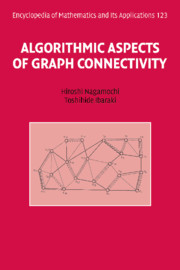Book contents
- Frontmatter
- Contents
- Preface
- Notation
- 1 Introduction
- 2 Maximum Adjacency Ordering and Forest Decompositions
- 3 Minimum Cuts
- 4 Cut Enumeration
- 5 Cactus Representations
- 6 Extreme Vertex Sets
- 7 Edge Splitting
- 8 Connectivity Augmentation
- 9 Source Location Problems
- 10 Submodular and Posimodular Set Functions
- Bibliography
- Index
6 - Extreme Vertex Sets
Published online by Cambridge University Press: 07 May 2010
- Frontmatter
- Contents
- Preface
- Notation
- 1 Introduction
- 2 Maximum Adjacency Ordering and Forest Decompositions
- 3 Minimum Cuts
- 4 Cut Enumeration
- 5 Cactus Representations
- 6 Extreme Vertex Sets
- 7 Edge Splitting
- 8 Connectivity Augmentation
- 9 Source Location Problems
- 10 Submodular and Posimodular Set Functions
- Bibliography
- Index
Summary
The concept of extreme vertex sets, defined in Section 1.5.3, was first introduced by Watanabe and Nakamura [308] to solve the edge-connectivity augmentation problem. The fastest deterministic algorithm currently known for computing all extreme vertex sets was given by Naor, Gusfield, and Martel [259]. Their algorithm first computes the Gomory–Hu cut tree of the graph and then finds all maximal k-edge-connected components for some k, from which all extreme vertex sets are identified by Lemma 1.42, taking O(n(mn log(n2/m)) running time. Bencz&úr and Karger [20] have given a Monte Carlo–type randomized algorithm, which runs in O(n2 log5n) time but is rather involved. Notice that computing all extreme vertex sets is not easier than finding a minimum cut since at least one of the extreme vertex sets is a minimum cut.
In this chapter, we give a simple and efficient algorithm for computing all extreme vertex sets in a given graph, and we show some applications of extreme vertex sets. The algorithm will be used to solve the edge-connectivity augmentation problem in Section 8.3. In Section 6.1,we design a deterministic O(nm + n2 log n) time algorithm for computing the family χ(G) of extreme vertex sets in a given edge-weighted graph G, which is a laminar family, as observed in Lemma 1.41. As a new application of extreme vertex sets, in Section 6.2 we consider a dynamic graph G in which the weight of edges incident to a designated vertex may increase or decrease with time and we give a dynamic minimum cut algorithm that reports a minimum cut of the current G whenever the weight of an edge is updated.
- Type
- Chapter
- Information
- Algorithmic Aspects of Graph Connectivity , pp. 191 - 216Publisher: Cambridge University PressPrint publication year: 2008



